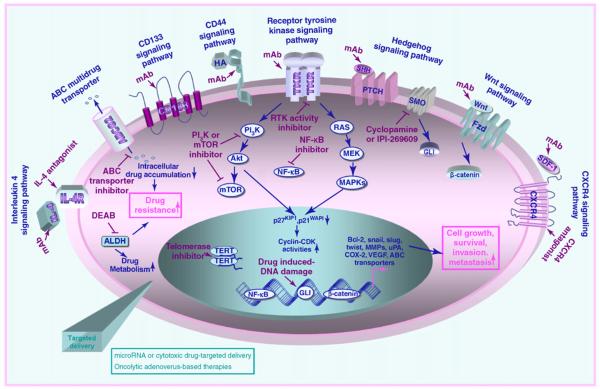FIGURE 2.
Potential signaling transduction pathways involved in the aggressive behavior and multidrug resistance phenotype of cancer- and metastasis-initiating cells and new cancer therapies by molecular targeting distinct signaling elements. The mitotic effects induced through the activation of distinct intracellular signaling pathways initiated by different growth factors, cytokines and chemokines in cancer stem/progenitor cells are illustrated. In particular, the possible upregulation of the expression levels of numerous gene products involved in the sustained growth, survival, invasion, and metastasis of cancer stem/progenitor cells are indicated. Moreover, a decrease in intracellular drug accumulation mediated via the ATP-binding cassette (ABC) multidrug efflux pump and enhanced drug metabolism via aldehyde dehydrogenase (ALDH) is also shown. The potential inhibitory effect induced by diverse pharmacological agents such as a selective inhibitor of receptor tyrosine kinase (RTK) activity (gefitinib, erlotinib, or lapitinib), smoothened (SMO) co-receptor of hedgehog (cyclopamine or IPI-269609), NF-κB, PI3K or mTOR signaling element, telomerase, ABC transporters, and ALDH (diethylaminobenzaldehyde, DEAD) in cancer cells is indicated. In addition, the inhibitory effect induced by a monoclonal antibody (mAb) directed against interleukin-4 (IL-4) ligand, CD44 receptor, RTK, sonic hedgehog ligand (SHH), Wnt ligand, stromal cell-derived factor-1 (SDF-1), or an antagonist of IL-4R and CXCR4 chemokine receptor are indicated. Abbreviations: COX-2, cylooxygenase-2, MMPs, matrix metalloproteinases, VEGF, vascular endothelial growth factor, uPA, urokinase plaminogen activator.

